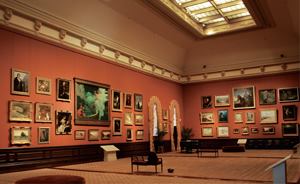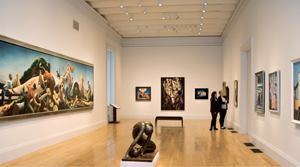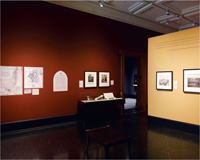Scott Rosenfield
In the 30-foot-tall Grand Salon in the Smithsonian American Art …
Testing the Waters
Perhaps the most significant progress made in LED lighting for lighting artworks in museums, the past year was in part a result of the U.S. Department of Energy (DOE)’s Solid-State Lighting Gateway demonstration projects. The projects investigate the use of LEDs in several exterior and interior lighting applications.
To date, five Gateway projects have focused on lighting museum artwork. The three projects cover a range of issues, including artwork conservation, human perception, and gallery installations. A fourth and ongoing investigation at the Burden Iron Works Museum in Troy, N.Y., looks at the compatibility of dimming systems with LEDs, and should wrap up at the end of 2012. “As a group, they’re going to be a wonderful and complete study on the state of LEDs at this point in time,” says Naomi Miller, senior lighting engineer at the Pacific Northwest National Laboratory.
Along with the fading studies conducted by Druzik and the GCI’s Museum Lighting Research Project, one of the Gateway projects examined the potential degradation of installed artwork under LED lamps. At two-week intervals between March and September 2011, Druzik studied the prints displayed at the “In Search of Biblical Lands: From Jerusalem to Jordan in Nineteenth-Century Photography” exhibition at the J. Paul Getty Museum, which was illuminated by LED PAR38 lamps, for color changes. No degradation was visibly detectable and the museum curators were satisfied with the quality of illumination from the LEDs. The Gateway report on the GCI studies will be published this spring.
For the Gateway project at the Jordan Schnitzer Museum of Art at the University of Oregon, LEDs were tested at two locations. In the first location, a gallery displaying photographs by artist Chris Jordan, the museum installed 54 12W LED PAR38 replacement lamps as accent lighting. During the exhibition, which ran through winter and spring 2011, the LED lamps only used 14 percent of the energy that standard halogen lamps would have consumed, according to the September 2011 Gateway report.
For its second location, the nearby Gordon Gilkey Study Center Gallery, the museum installed a blind side-by-side comparison of three LED lamps and one halogen lamp on oil paintings, and invited museum staff members and visitors to assess the lamps’ performance. Museum staff preferred the same LED lamp that was used in the Jordan exhibit, while visitors favored another test LED replacement lamp. Both user groups noted an “improved ability to see blue colors.” Lamp preferences did not correlate with the color-rendering index (CRI); while the halogen lamp had a CRI of 99, the museum staff–selected LED had a CRI of 93, and the visitors’ choice LED had a CRI of 85. The report concluded “that carefully chosen LED replacement lamps can provide an equivalent or even preferred appearance of art in comparison to halogen lamps” at a fraction of the energy used by the latter.
In 2010, museum lighting specialist Scott Rosenfeld collaborated with Naomi Miller on a Gateway project at the Smithsonian American Art Museum (SAAM) in Washington, D.C.. In 2011, after a series of mock-ups, they selected LED lamps to test in four sites: the early Modernism gallery and the Luce Foundation Center for American Art at the SAAM’s main building, and two spaces in the Renwick Gallery, SAAM’s branch for American craft.
In the early Modernism gallery, Rosenfeld and Miller installed PAR30 retrofit LEDs with 10-, 25-, and 40-degree beam spreads and MR16 retrofit LED lamps with a 4-degree beam spread. “The range of beam spreads was key,” says Rosenfeld, who used a custom-made AR111 adapter ring with a GX5.3 base to integrate the MR16 lamps into PAR36/AR111 fixtures. After “tweaking the chromaticity” of the lamps with filters, they found the artworks’ illumination by the LEDs to be successful.
At the Renwick Gallery, PAR38 LED lamps with 10- and 25-degree beam spreads, along with MR16 retrofit LED lamps with a 4-degree beam spread, illuminated a gallery that first hosted a glass sculpture installation and then a display of artworks in different media. The results were “fabulous,” Rosenfeld says. “I was able to maintain the illuminance by going to LED and saved about 75 percent on electricity.”
In roughly 30 percent of the Renwick’s 30-foot-tall Grand Salon, Rosenfeld and Miller installed 16W LED PAR38 lamps with a 10-degree beam spread to replace 50W to 120W incandescent spotlights. For the most part, the changes were imperceptible as each bank of fixtures was switched out. But for the existing 250W floodlights and most of the 4-degree PAR46 lamps, “there was no LED option,” Rosenfeld says.
For the fourth test site at the Luce Center, Rosenfeld and Miller searched for LED lamps that would match the chromaticity of the existing halogen MR16s. However, because of compatibility issues between the components, the contenders flickered with the electric transformers used in the tracklighting (the MR16 lamps installed in the early Modernism gallery were powered on a magnetic transformer) and the test was declared a no-go.
The LED lamps for the four SAAM sites were first tested by an independent laboratory in their initial new state, and then will undergo additional testing after a year in the field. The Gateway report with these results is expected to be published this coming June.
The DOE’s Gateway projects and museum-specific studies have “had a catalytic effect on other museums,” Druzik says. The Museum of Fine Arts in Boston, for example, installed LED fixtures in its second-floor Koch Gallery last November. Lighting the Baroque paintings, hung salon style, with tracklighting in the 30-foot-tall space has always been difficult. Matthew Siegal says, “Some of the paintings disappeared as they climbed up the wall.” Traditional MR16s—150W fixtures dimmed down to about 25W—lit half of the gallery, while 2700K LED fixtures—approximately 15W brought down to about 5W—illuminated the other half.
The results are “fantastic,” Siegal says. “The paintings are really popping under the LEDs,” and “the intensity of light on a throw that long is 10 times what it is on an incandescent.”
The MFA is now looking for funding to relamp the entire gallery. Siegal estimates that the energy savings from LEDs could significantly reduce the museum’s annual utility bill, 37 percent of which goes toward lighting and 15 percent to cooling. “The potential is unbelievable,” he says.
The Future Awaits On the one hand, LED technology is advancing extremely fast; on the other hand, related lighting technologies and components are not necessarily advancing quickly enough to keep pace with the recent crop of LEDs. With more art institutions exploring the potential of solid-state lighting in their galleries and exhibits, museums now have the beginnings of a body of research findings that they can use to evaluate their options. Still, many designers would like to see improvements in areas such as performance, product offerings, costs, size, and standardization before making the investment.
Druzik, who equates the progress of LEDs to that of the personal computer, takes a more laissez-faire approach. “If you have an idea of what you’d like to see, it might not be that useful in five years,” he says. “Instead, it’ll probably be improved, and it’ll be surprising in the way it’s been improved.”


